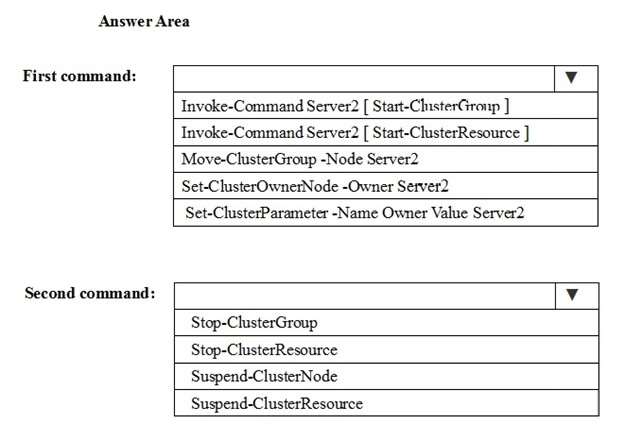HOTSPOT
You have a Windows Server 2016 failover cluster that contains two servers named Server1 and Server2.
You need to apply patches to Server1.
Which two commands should you run before you apply the patches? To answer, select the appropriate options
in the answer area.
Hot Area:

Explanation:
References:
https://support.microsoft.com/en-us/help/174799/how-to-update-windows-server-failover-clusters https://technet.microsoft.com/en-us/library/ee461003.aspx



First part is correct as: “Moving a resource group is a way of simulating failover. Running this cmdlet is also an appropriate step to take in preparation for routine maintenance on a node”
https://docs.microsoft.com/en-us/powershell/module/failoverclusters/move-clustergroup?view=win10-ps
But the second one is wrong. As the last thing we want to do is stopping the CLUSTER resource.
The second pat is then (in my opinion it would be OK to use it alone without the first command): Suspend-ClusterNode as it states:
“Pausing, or suspending, a node is usually done when applying software updates to the node.” after: https://docs.microsoft.com/en-us/powershell/module/failoverclusters/suspend-clusternode?view=win10-ps
23
0
Correct assessment.
Move-ClusterGBroup -Node Server2 – in order to move roles off of server 1.
Suspend-ClusterNode to suspend Server1 prior to patching.
17
0
I wish the question was more clear. There’s nothing to indicate the resources are in a cluster group so I guess we must assume they are?
0
0
This question is confusing in assignment.
Suspend-ClusterNode -Name “server1” -Target “server2” -Drain
It do all in one step.
But is possible
Move-ClusterGroup -Node server2
and Suspend-ClusterNode -Name server1
I saw this in
but are all resources in ClusterGroup ????????????
This question do some people from Microsoft book without practical
experience.
This is confusing question.
I saw in Second Command – Stop-ClusterResource – Takes a resource offline in a failover cluster. This is sad.
0
0